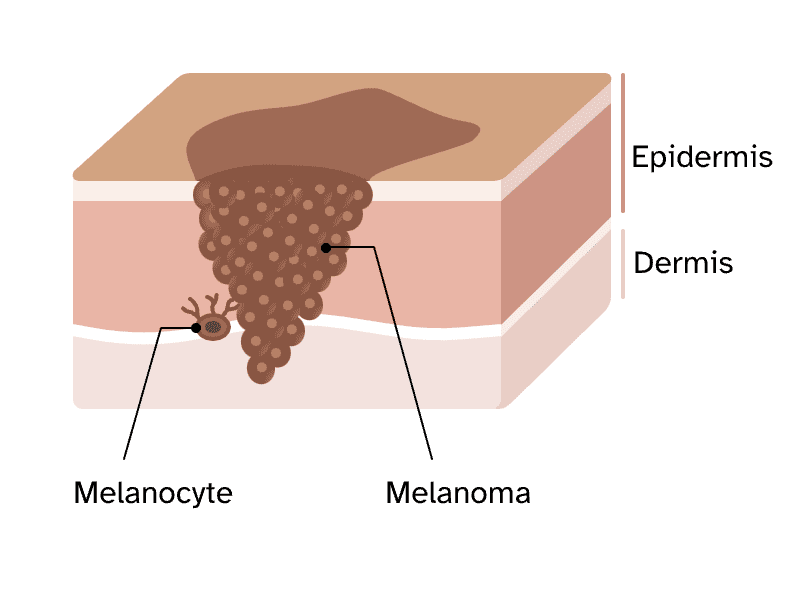Explore Melanoma and what your DNA can tell you
What is melanoma?
Melanoma is the most serious type of skin cancer. It begins in melanocytes, which are cells that make melanin — the pigment that gives the skin its color. The most common cause of melanoma is too much exposure to ultraviolet (UV) light from the sun (including through clouds and glass windows). In addition, UV light exposure from tanning beds and sun lamps increases the chances of developing melanoma.
Melanoma usually develops on areas of skin that get a lot of sun exposure. The most common locations include the head, back, arms, and legs. However, it can also develop on other parts of the body that don’t get a lot of sun exposure, including the soles of the feet, the palms, and under the fingernails, especially for people with darker skin. There are also forms of melanoma that develop in places other than the skin, including the eyes and mucous membranes like the inside of the mouth. Melanoma can appear in many ways, including a change to an existing mole or the development of a new spot that looks like a mole or growth on the skin.

How can melanoma impact your health?
If not caught early, melanoma is more likely than other types of skin cancer to spread to other parts of the body, such as the lungs, liver, brain, and bones. This can cause serious complications that can be life-threatening. But when caught at an early stage, the risk of spreading is reduced, and the melanoma is usually easier to treat. This is why it’s so important to protect your skin, get familiar with your skin’s appearance, perform regular skin self-checks, and learn the ABCDEs of melanoma to help spot the signs early. Talk to a healthcare professional like a dermatologist if you notice any unusual changes.

Is melanoma genetic?
Genetics do play a role in melanoma. This means some people will be more likely to develop it based on their genetics.
For all individuals, genetic testing is available to identify variants linked to the different types of melanoma. Additional genetic factors may be discovered in the future.
How does skin color play a role?
While people with lighter skin are more likely to develop melanoma, people with any skin color can develop melanoma and other skin cancers. And people with darker skin are more likely to be diagnosed with melanoma at a later stage, when it can be harder to treat. This may be due to multiple factors, including that patients and healthcare providers may be less familiar with the typical appearance and location of melanoma on skin of color. People with darker skin are more likely to develop melanoma in locations that get less sun exposure, such as the soles of the feet, the palms, and beneath the fingernails. Learn more about skin cancer in people of color from the American Academy of Dermatology.
Did you know?
More than 1 million Americans are living with melanoma. In addition to genetics, sun exposure, and family history, your age and certain physical characteristics can also impact your chances of developing melanoma. Melanoma becomes more common as people get older, although it can also affect younger people. And people with many moles, along with those with light skin, blue or green eyes, blonde or red hair, or freckles are also more likely to develop melanoma.
Explore more
Interested in learning how your genetics may be related to melanoma? Find out more with the Skin Cancer (Melanoma) report (Powered by 23andMe Research), part of the 23andMe+ Premium membership. 23andMe+ Premium includes everything in our Health + Ancestry Service plus new premium reports and features throughout the year.

23andMe+ Premium
Please note:
- The Skin Cancer (Melanoma) report does not diagnose melanoma and should not be used to make medical decisions.
- The report was developed by 23andMe scientists using data and insights gathered from thousands of customers who consent to participate in our research. Reports based on 23andMe research provide an estimate of your likelihood of developing a condition based on your genetics and other factors. This report does not account for lifestyle or family history.
- The report does not account for every possible genetic variant that could affect your likelihood of developing melanoma.
- ‚Note that customers of certain ethnicities may not receive a genetic result. To learn more about this limitation, please see our Help Center article. These reports have not been reviewed by the FDA.
References:
American Academy of Dermatology Association. “Skin Cancer: Incidence rates.” Retrieved June 3, 2021, from https://www.aad.org/media/stats-skin-cancer.
American Cancer Society. “Melanoma Skin Cancer.” Retrieved December 2, 2021, from https://www.cancer.org/cancer/melanoma-skin-cancer.html
Bradford PT. (2009). “Skin Cancer in Skin of Color.” Dermatol Nurs. 21(4):170–178.
Centers for Disease Control and Prevention. “Basic Information About Skin Cancer.” Retrieved June 3, 2021, from https://www.cdc.gov/cancer/skin/basic_info/index.htm.
Gupta AK et al. (2016). “Skin Cancer Concerns in People of Color: Risk Factors and Prevention.” Asian Pac J Cancer Prev. 17(12): 5257–5264.
Mayo Clinic. “Melanoma.” Retrieved June 3, 2021, from https://www.mayoclinic.org/diseases-conditions/melanoma/symptoms-causes/syc-20374884.
National Cancer Institute. “Cancer Stat Facts: Melanoma of the Skin.” Retrieved June 3, 2021, from https://seer.cancer.gov/statfacts/html/melan.html.
Skin Cancer Foundation. “Skin Cancer Facts & Statistics.” Retrieved November 4, 2021, from https://www.skincancer.org/skin-cancer-information/skin-cancer-facts/.